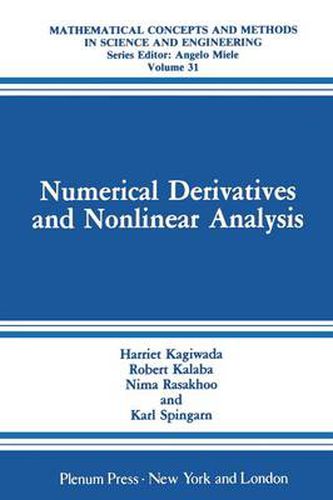Readings Newsletter
Become a Readings Member to make your shopping experience even easier.
Sign in or sign up for free!
You’re not far away from qualifying for FREE standard shipping within Australia
You’ve qualified for FREE standard shipping within Australia
The cart is loading…






This title is printed to order. This book may have been self-published. If so, we cannot guarantee the quality of the content. In the main most books will have gone through the editing process however some may not. We therefore suggest that you be aware of this before ordering this book. If in doubt check either the author or publisher’s details as we are unable to accept any returns unless they are faulty. Please contact us if you have any questions.
For many years it has been an article of faith of numerical analysts that the evaluation of derivatives of complicated functions should be avoided. Derivatives were evaluated using finite differences or, more recently, using symbolic manipulation packages. The first has the disadvantage of limited accuracy. The second has disadvantages of being expensive and requiring considerable computer memory. The recent developments described in this text allow the evaluation of derivatives using simple automatic derivative evaluation subroutines pro grammed in FORTRAN or BASIC. These subroutines can even be programmed on a personal computer. The concept for the evaluation of the derivatives was originally developed by Wengert over 20 years ago. Significant im provements have been made in Wengert’s method and are utilized in this text. The purpose of this text is to familiarize computer users with a simple and practical method for obtaining the partial derivatives of complicated mathematical expressions. The text illustrates the use of automatic deriva tive evaluation subroutines to solve a wide range of nonlinear least-squares, optimal control, system identification, two-point boundary value problems, and integral equations. The numerical values of the derivatives are evalu~ ated exactly, except for roundoff, using simple FORTRAN or BASIC sub routines. These derivatives are derived automatically behind the scenes, from the equivalent of analytical expressions, without any effort from the user. The use of costly software packages is not required.
$9.00 standard shipping within Australia
FREE standard shipping within Australia for orders over $100.00
Express & International shipping calculated at checkout
This title is printed to order. This book may have been self-published. If so, we cannot guarantee the quality of the content. In the main most books will have gone through the editing process however some may not. We therefore suggest that you be aware of this before ordering this book. If in doubt check either the author or publisher’s details as we are unable to accept any returns unless they are faulty. Please contact us if you have any questions.
For many years it has been an article of faith of numerical analysts that the evaluation of derivatives of complicated functions should be avoided. Derivatives were evaluated using finite differences or, more recently, using symbolic manipulation packages. The first has the disadvantage of limited accuracy. The second has disadvantages of being expensive and requiring considerable computer memory. The recent developments described in this text allow the evaluation of derivatives using simple automatic derivative evaluation subroutines pro grammed in FORTRAN or BASIC. These subroutines can even be programmed on a personal computer. The concept for the evaluation of the derivatives was originally developed by Wengert over 20 years ago. Significant im provements have been made in Wengert’s method and are utilized in this text. The purpose of this text is to familiarize computer users with a simple and practical method for obtaining the partial derivatives of complicated mathematical expressions. The text illustrates the use of automatic deriva tive evaluation subroutines to solve a wide range of nonlinear least-squares, optimal control, system identification, two-point boundary value problems, and integral equations. The numerical values of the derivatives are evalu~ ated exactly, except for roundoff, using simple FORTRAN or BASIC sub routines. These derivatives are derived automatically behind the scenes, from the equivalent of analytical expressions, without any effort from the user. The use of costly software packages is not required.